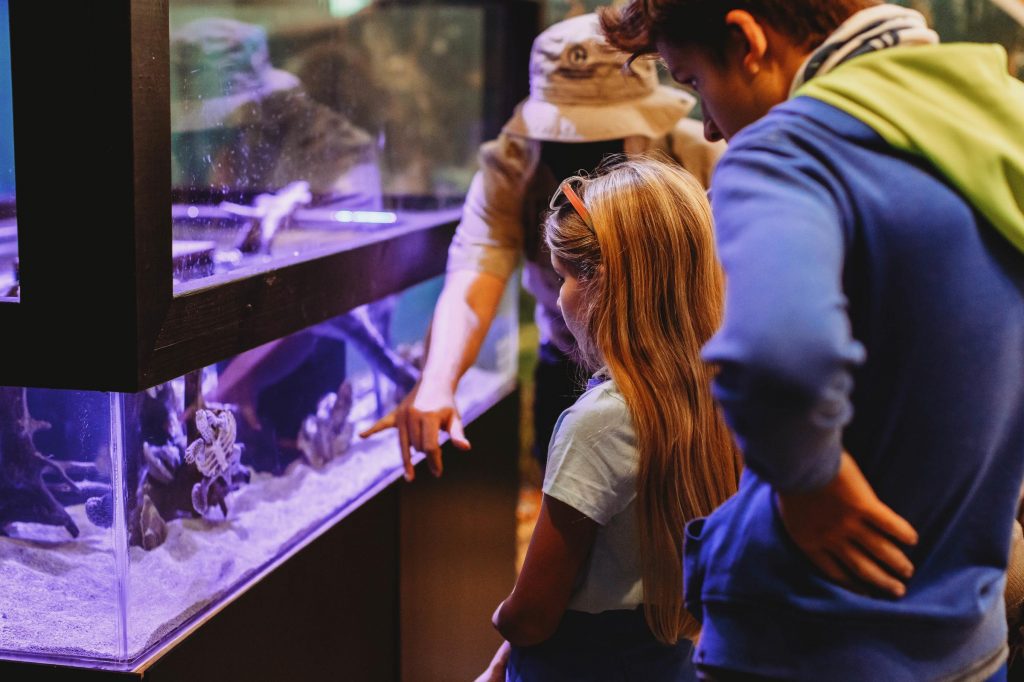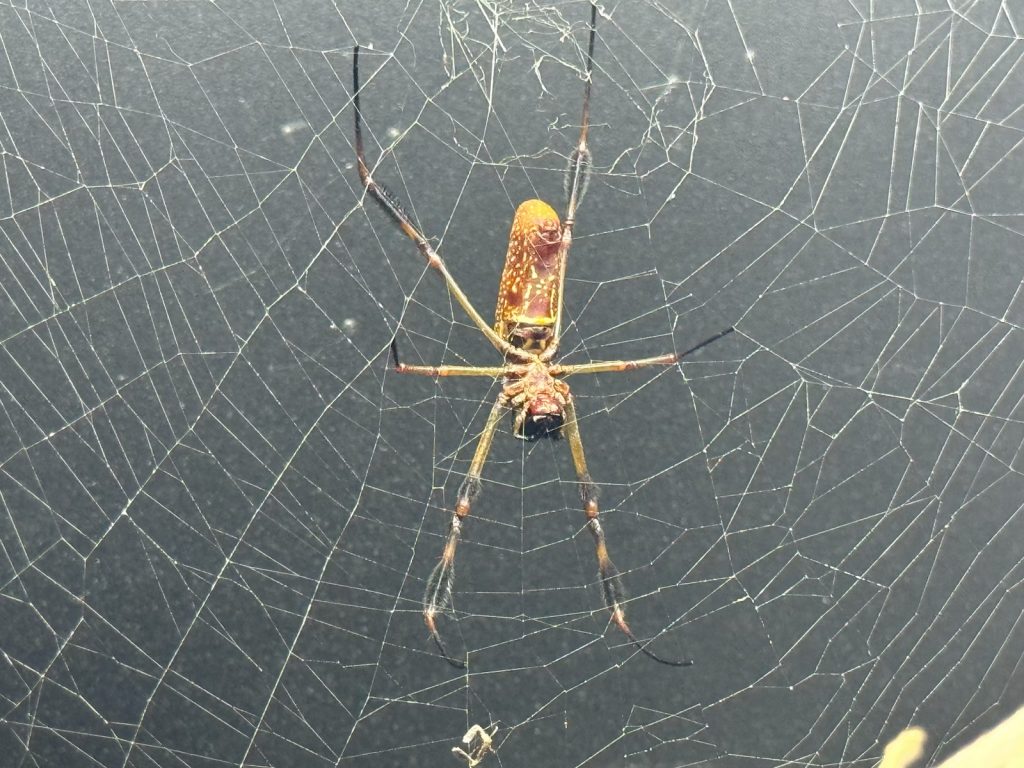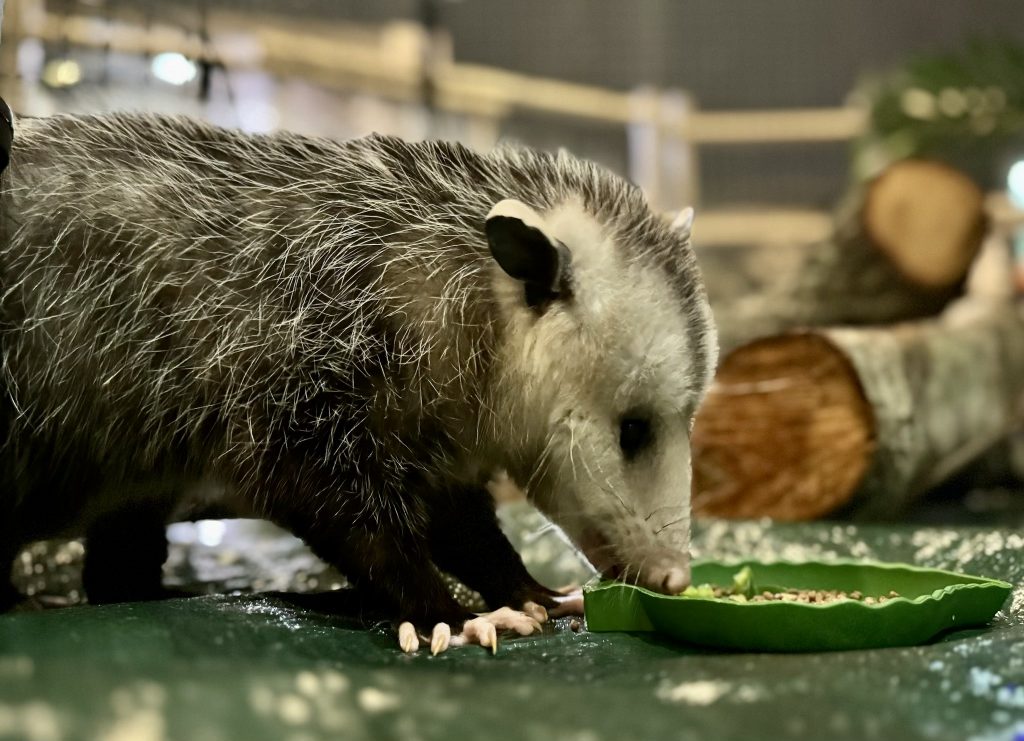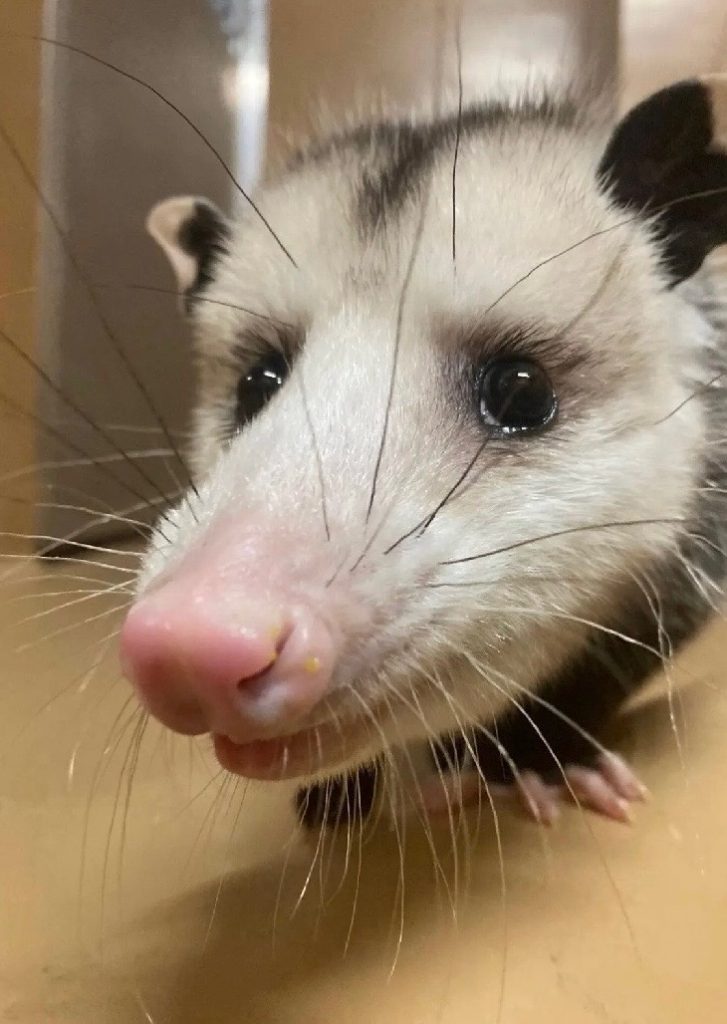Immerse yourself in the world of Florida’s animals at CMA’s new exhibit! From a curious opossum to slithering snakes, you’ll get the chance to see a variety of fascinating animals up close. A range of species will be showcased, including amphibians, arthropods, reptiles, fish and small mammals, all to help educate visitors about both native and invasive species in Florida.
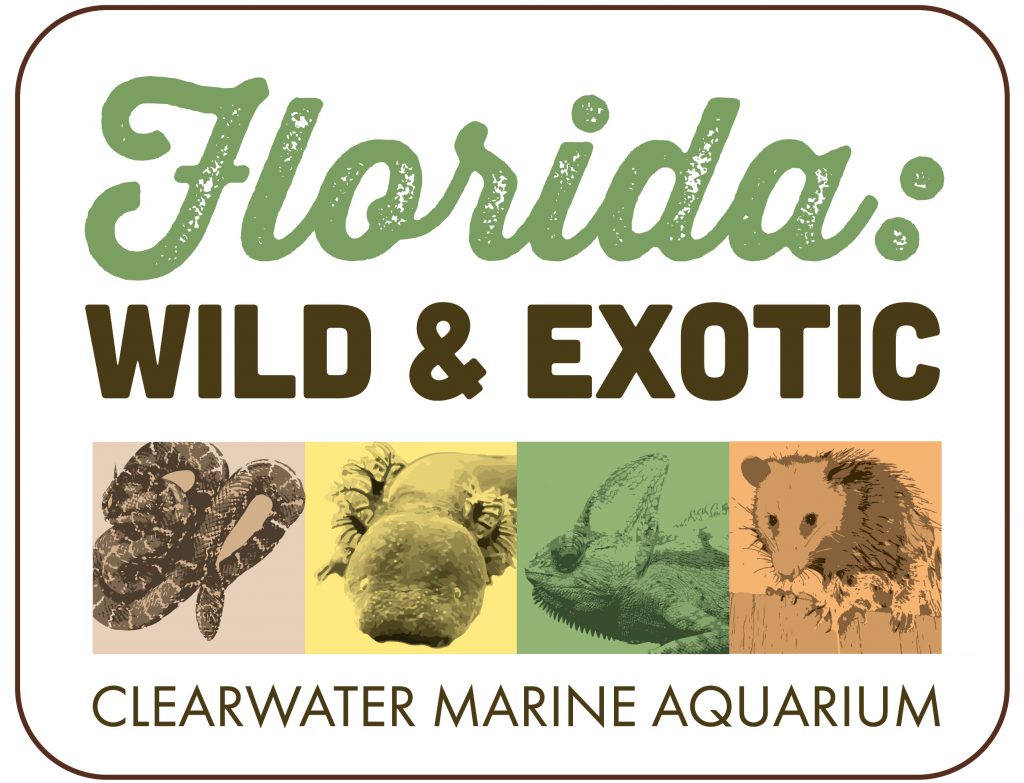
Exhibit Details
- Species in this Area
- Florida kingsnake, Perdido Key beach mice, Virginia opossum, bark scorpion, lesser siren, cane toad, golden silk spider, Colombian red-tailed boa, Smallwood’s anole, hermit crabs, sargassum fish, Tokay gecko, veiled chameleon
- Location
- Atlantis Theater – Level 1 Original CMA
Explore the Exhibit
Florida Native Species
Florida Kingsnake
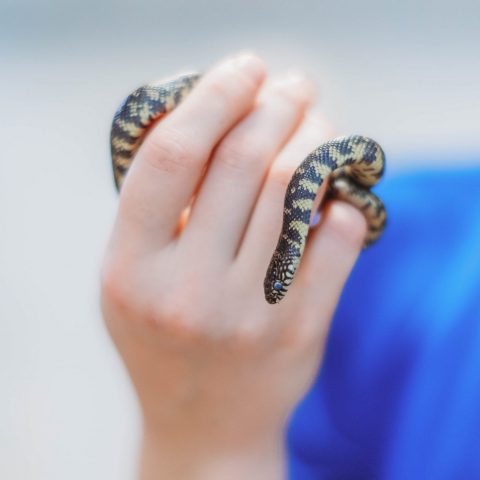
- AVERAGE SIZE
- 36-48 In
- HABITAT
- Florida’s Prairies, Marshes, Scrubs, and Estuaries
- DIET
- Other non-venomous and venomous snakes, mice, birds, amphibians, eggs and insects
- LIFESPAN
- 5-20+ years
- RANGE
- Florida peninsula
Conservation Efforts:
Florida kingsnakes are threatened by habitat loss due to deforestation and urbanization, predation, vehicle strikes, and pet trade harvest.
How You Can Help:
By doing things such as educating ourselves and others, making ethical decisions surrounding wildlife, and using our voices to support vulnerable species, we can ensure animals like the Florida kingsnake are preserved!
Perdido Key Beach Mice
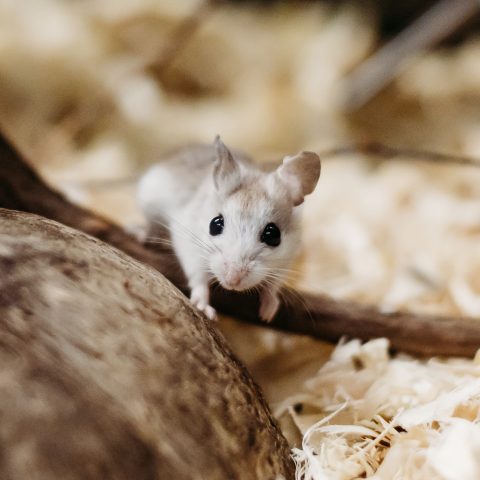
- AVERAGE SIZE
- 13 grams
- HABITAT
- Coastal Dunes
- LIFESPAN
- Up to 6 years
- STATUS
- Endangered species
- LOCATION
- Perdido Key, Florida & Baldwin County, Alabama, Dunes
- THREATS
- Habitat loss due to hurricanes, construction and foot – traffic damaging vegetation on dunes
- RANGE
- Florida and Alabama
- DIET
- Seeds, fruit, and insects
Conservation Efforts:
The Perdido Key beach mouse is critically endangered, and its biggest threat is the development along beaches. Building on beaches destroys or damages the sand dunes these mice need for shelter and food. More foot traffic also harms dune plants that the mice rely on. Protecting their habitat is crucial to help these beach mice survive, as they are protected under both federal and state laws.
How You Can Help:
You can help protect the endangered Perdido Key beach mouse by staying off coastal sand dunes in their habitat areas. This helps preserve their food sources and shelters. Sharing their story with others also raises awareness, which is a key step in ensuring their survival.
Virginia Opossum
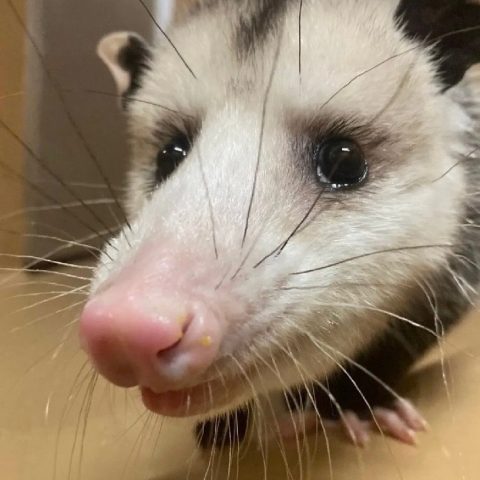
- AVERAGE SIZE
- 4-12 pounds
- HABITAT
- The opossum inhabits a diverse range of environments, including forests, swamps, and urban areas. They commonly seek shelter in trees, animal dens, barns, sheds, and under human structures.
- Opossum Smell
- Not only do opossums play “dead” when they become scared they also release a foul-smelling liquid from their lower half. This allows them to mimic the smell and state of other dead organisms which acts as a warning to other animals. While opossums may smell unpleasant this is just a part of their defense strategy
- DIET
- As omnivores, Virginia opossums have a varied diet that includes plants, insects, small animals, and carrion.
- Range
- Range from Southern Canada to Nicaragua and Honduras.
Benjamin’s Rescue Story:
The exhibit features Benjamin the opossum, who has been acclimating to his habitat since CMA welcomed him in September 2024. He was brought to CMA for rehabilitation from the Nature World Wildlife Rescue from Homosassa Springs, Florida after he was attacked by a dog when he was about one month old.
Because he was shaken, he currently exhibits long-lasting neurologic and physical deficits, including the inability to balance, curving/tilting to the right, inability to turn or climb down trees, and inability to hold an item and balance simultaneously. Benjamin was approximately five months old and weighed about five pounds in November 2024.
Conservation Efforts:
As opportunistic feeders, they play a crucial role in the ecosystem by consuming carrion, venomous snakes and diseased ticks. However, their foraging near busy roads exposes them to significant risks from speeding vehicles. Maintaining healthy habitats for the opossum helps to protect them.
How You Can Help:
Leaving opossums undisturbed and promoting education about these animals and their habitats is essential for their conservation and for ensuring their survival for future generations.
Golden Silk Spider

- AVERAGE SIZE
- Females: 24mm-40mm long; Males: 6mm
- LIFESPAN
- About 1 year
- HABITAT
- Webs are mostly found at the edges of forest clearings, alongside forest trailes, and across forest water courses.
- DIET
- Small to medium flying insects, including fies, bees, wasps and small moths and butterflies.
- Range
- Western Hemisphere: Florida, West Indies, as far north as North Carolina, across the gulf states, through Central America, and into South America as far as Argentina.
Land Hermit Crab
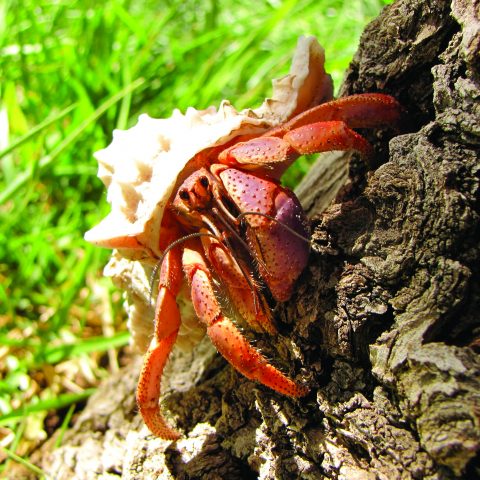
- AVERAGE SIZE
- The size of a baseball
- HABITAT
- Mangrove forests and salt marshes
- DIET
- Vegetation, detritus, and decaying animals
- LIFESPAN
- 70 Years
- Range
- Western Atlantic; Belize, South Florida, Venezuela, and West Indies
Lesser Siren
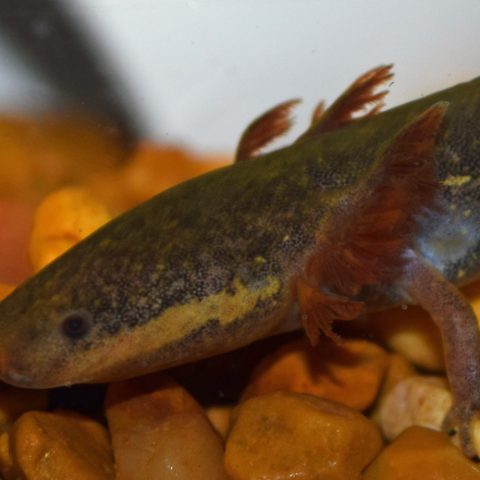
- AVERAGE SIZE
- 7-25.6″ long
- HABITAT
- Shallow and quiet waters
- DIET
- Aquatic invertebrates
- RANGE
- North and Central Florida
Conservation Efforts:
While currently considered of Least Concern on the IUCN Red List, habitat loss is the biggest threat to lesser sirens. The wetlands that the lesser sirens live in are vital habitats to these ecosystems and are prone to destruction, often due to residential construction and flood control.
How You Can Help:
A wide variety of species depend on wetlands, including the greater siren. While many wetlands are already protected in the US, we should ensure the waters entering these habitats are clean and healthy for the organisms that call them home. Some easy ways you can help are by responsibly handling trash, participating in cleanups, and conserving water—no matter where you are in the world.
Lined Seahorse
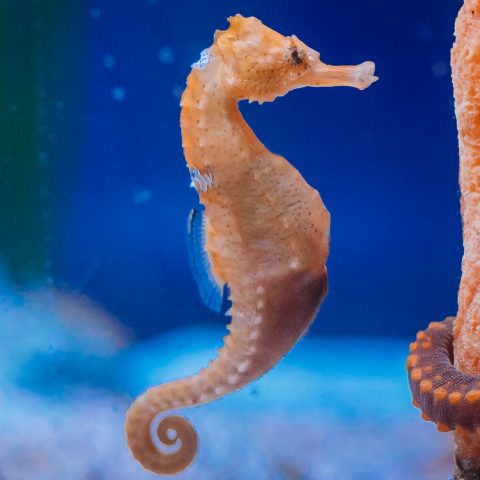
- AVERAGE SIZE
- 2.5-7.5″ long
- LIFESPAN
- 33-38 months
- HABITAT
- Lives 2-230 feet deep near seagrass. mangroves, sponges, corals, and even floating sargassum.
- DIET
- The northern seahorse eats small crustaceans, amphipods, and gastropods, using its elongated snouts
- Range
- Found from Cape Cod down through the Gulf of Mexico and South to the Atlantic coast of South America to Uruguay
Conservation Efforts:
The northern seahorse is a vulnerable species with a population thought to be declining. This species is targeted by the aquarium fishery trade and the habitats they are found in face many threats. Coral reefs, seagrass beds, and mangroves face threats such as land development, warming ocean temperatures, and pollution.
How You Can Help:
To protect the northern seahorse and their natural habitats, keep our waterways clean, pick up trash when visiting the beach, and be mindful of pesticide use that can harm our waterways.
Invasive Species
Smallwood Anole
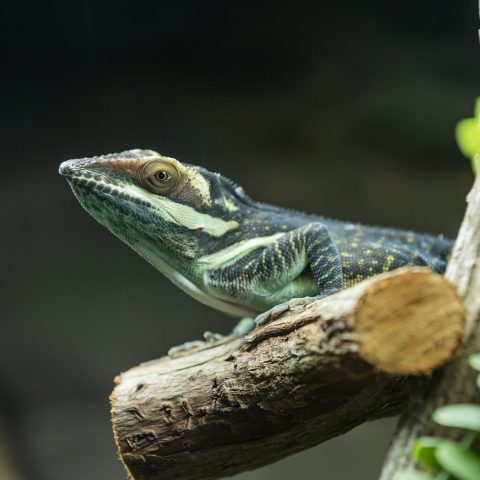
- HABITAT
- Semi-deciduous, evergreen, gallery forests, rainforest, mangroves, and coffee plantations.
- GEOGRAPHICAL DISTRIBUTION
- Native to Cuba
- PREY
- Insects, grubs, and tree frogs
- PREDATORS
- Snakes and birds
Cane Toad

- AVERAGE SIZE
- 2 kg
- HABITAT
- Forested areas with water nearby
- DIET
- Carnivores that feed on invertebrates, vertebrates, and carrion
- RANGE
- Native from the Rio Grande Valley to the Central Amazon and southeastern Peru, with introductions in the Caribbean, South Florida, Hawaii, and Australia’s east coast
Conservation Efforts:
The cane toad was introduced to Florida in the 1930s for pest control but failed to establish a population. In the 1950s, intentional or accidental releases led to their spread throughout Florida and beyond. Cane toads, which have invaded ecosystems globally, pose a serious threat due to their toxicity, harming native wildlife and disrupting local ecosystems.
How You Can Help:
To reduce cane toad impacts in Florida and protect your pets, avoid attracting toads by turning off outdoor lights, removing pet food at night, and eliminating sources of water and debris in your yard. Keep pets supervised during dawn, dusk, and nighttime when toads are active, and consider using a nuisance wildlife trapper if needed. Report any cane toad sightings on the “IveGot1” app to help research teams monitor their spread.
Veiled Chameleon

- AVERAGE SIZE
- Average 17-24 inches (male) and 10-14 inches (female) long
- HABITAT
- Arboreal species
- DIET
- Insects and leaves of plants
- RANGE
- Yemen and Saudi Arabia
Conservation Efforts:
While it has been collected for the pet trade, exports from Arabia have decreased making them of Least Concern by the IUCN Red List. Localized threats, such as road development and infrastructure, may increase roadkill incidents.
How You Can Help:
If you’re looking to adopt a pet, ask where the store or individual sources their animals to ensure you’re not contributing to the problem. This reduces over-harvesting and encourages a shift towards more sustainable practices in the industry. Advocate for habitat protection such as wildlife crossings or road signage to prevent roadkill incidences.
Red-Tailed Boa

- AVERAGE SIZE
- Average 15-50 pounds and up to 10 feet long
- HABITAT
- Tropical, subtropical, and dry forests, mangrove swamps, scrublands, and wetlands
- DIET
- Small mammals, birds, snakes, lizards, and eggs
- Range
- South America from Venezuela to Argentina
Conservation Efforts:
Red-tailed boas are vulnerable to habitat loss, hunting for their meat, and pet trade harvest. These animals are a non-native species that became introduced to Florida – likely due to the irresponsible release of individuals brought to the state in the pet trade.
How You Can Help:
By choosing to support sustainable practices and responsibly sourced pets, you can help protect native populations and the environment. If you’re looking to adopt a pet, ask where the store or individual sources their animals to ensure you’re not contributing to the problem. This reduces over-harvesting and encourages a shift towards more sustainable practices in the industry. If you are looking to adopt an animal, make sure you do your research, as many of these animals end up released and abandoned in a non-native habitat, which can lead to invasive species or the suffering of the individual.
Bark Scorpion
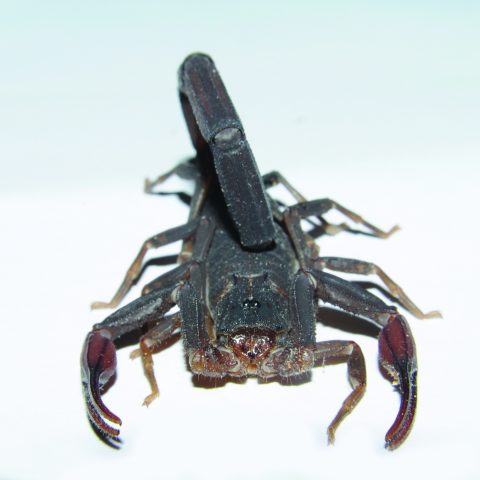
- AVERAGE SIZE
- 2-4″ long
- HABITAT
- Under bark and stones, in wood piles, and inside houses
- RANGE
- Africa, Europe, North America, Central America & the Caribbean, and South America
- DIET
- Other insects like roaches, termites, and crickets
Conservation Efforts:
It is believed that the bark scorpion was introduced from the tropics by boat. While venomous, it is not considered dangerous or deadly, so minimal research has been conducted. However, it remains a safety concern as it can take up residence in homes.
How You Can Help:
Introduced species can outcompete native species by taking over habitats and resources, disrupting local ecosystems. To prevent this, it is crucial to use safe shipping practices that reduce the chances of unintentionally spreading non-native species.
Tokay Gecko
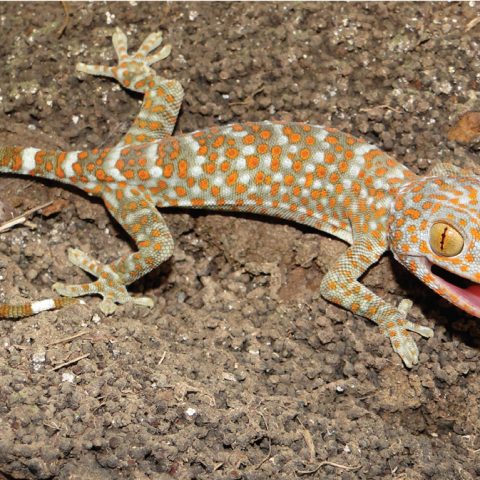
- AVERAGE SIZE
- Average 13-16 inches (male) and 8-12 inches (female) long
- LIFESPAN
- 8-10 years
- HABITAT
- Tropical rainforests and rock crevices
- RANGE
- Across Southeast and east Asia
- DIET
- Invertebrates and sometimes small rats, mice, and snakes
Conservation Efforts:
They are currently of Least Concern on the IUCN Red List but their population in China has sharply declined due to over-hunting for pet trade and habitat destruction from urbanization.
How You Can Help:
By choosing to support sustainable practices and responsibly sourced pets, you can help protect native populations and the environment. If you’re looking to adopt a pet, ask where the store or individual sources their animals to ensure you’re not contributing to the problem.
